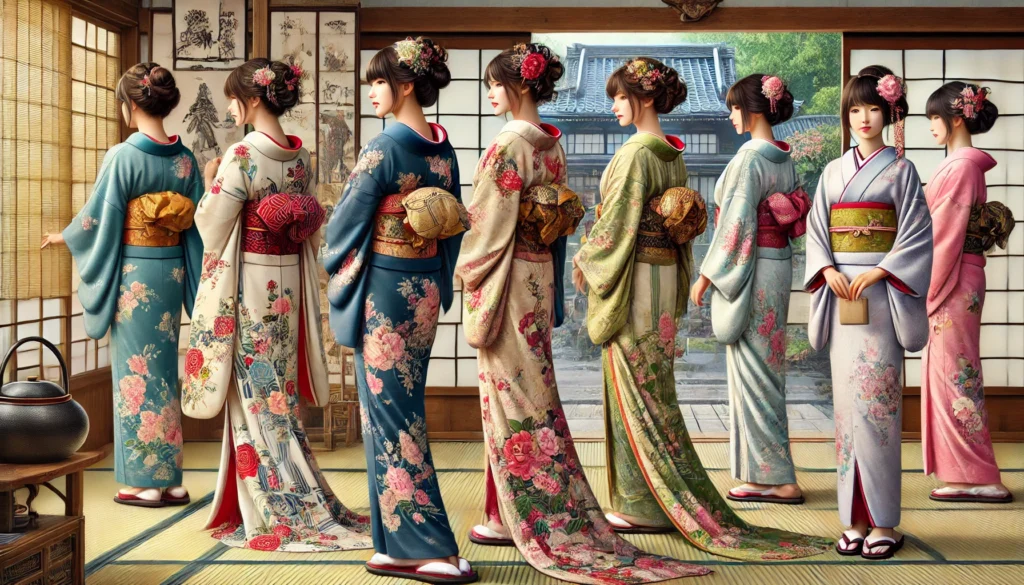Table of Contents
Introduction to Traditional Japanese Clothing
Traditional Japanese clothing, notably represented by garments such as kimonos and yukatas, exudes a rich cultural heritage that has evolved over centuries. These garments are not just clothing; they embody the identity, artistry, and traditions of the Japanese people, showcasing an array of styles, materials, and meanings that reflect historical and societal changes.
The kimono, which translates to “thing to wear,” has a history dating back to the Heian Period (794-1185). Originally, kimonos were worn by all classes and sexes, characterized by their intricate designs and elaborate patterns, often signifying the wearer’s status, age, and occasion. As time progressed, various styles emerged, with specific types of kimonos introduced for different seasons and events, emphasizing the connection between clothing and Japanese cultural practices. The use of luxurious fabrics, vibrant colors, and meticulous craftsmanship further underlines the significance of kimonos in conveying aesthetic values and cultural expression.
In contrast, the yukata, a lighter cotton garment, was traditionally worn during the summer months and various festivals. Originating from the kimono, it represents a more casual approach to dressing while still highlighting the importance of traditional attire in contemporary Japanese life. The yukata’s simplicity and comfort have made it a popular choice for special events, such as hanabi (fireworks) festivals and traditional tea ceremonies. Over the years, both of these garments have undergone transformations, adapting to modern fashion while maintaining their cultural relevance.
This historical context illustrates how kimonos and yukatas are not mere clothes but symbols of Japanese culture that reflect various aspects of life and tradition. Understanding their origins and significance offers insight into the broader narrative of Japan’s identity and its enduring appreciation for traditional crafts and clothing.

The Kimono: A Detailed Overview
The kimono, a traditional garment of Japan, is renowned for its elegant design and rich cultural significance. Characterized by its T-shaped, wrap-around style, the kimono is constructed from a variety of fabrics, which contribute to its distinctive appearance and comfort. Common materials used for kimonos include silk, cotton, and synthetic blends, each offering unique textures and durability. The choice of fabric often depends on the occasion and the season, with lighter materials preferred in warmer months.
A key component of the kimono is the obi, a wide sash that is used to secure the garment at the waist. The obi is available in numerous styles and variations, with some being elaborate and decorative, while others are simpler and more functional. The way the obi is tied can vary, representing different levels of formality or even personal expression. Additionally, the layering of kimonos can enhance their aesthetic appeal; for instance, undergarments like the nagajuban can be worn beneath the kimono to protect it and add dimension to the outfit.
Color and patterns in kimono design carry significant meanings. Bright hues typically symbolize joy and celebration, making them suitable for festivities such as weddings. Conversely, muted tones might represent mourning or more somber occasions, showcasing the versatility of this traditional attire. The patterns, ranging from floral motifs to geometric designs, often reflect seasonal themes or cultural narratives, highlighting the connection between the garment and Japan’s natural beauty.
Kimonos are traditionally worn during notable events such as tea ceremonies, festivals, and family celebrations, representing respect for heritage and social customs. Understanding the kimono’s components, fabric types, and associated meanings not only enriches one’s appreciation of this remarkable clothing but also underscores its place as a vibrant symbol of Japanese culture.
The Yukata: A Casual Alternative
The yukata is an informal version of the traditional kimono, primarily worn during the warmer months. This light garment is typically made of cotton, making it an ideal choice for summer wear, as it provides comfort while allowing for breathability in hot and humid conditions. The fabric used for yukatas often features vibrant patterns and colors, with designs ranging from floral motifs to nature-inspired images, appealing to a wide audience. This versatility in aesthetics contributes to the yukata’s popularity, particularly among younger generations and during festive occasions.
Yukatas are generally worn at summer festivals, known as hanabi taikai, where fireworks displays and celebrations are common. At these events, one can witness a myriad of individuals adorned in colorful yukatas, creating a lively and festive atmosphere. Furthermore, the yukata is frequently preferred for other casual outings, such as picnics or beach visits. Unlike the more formal kimono, which often requires intricate obi ties and accessories, the yukata is easier to don and comes with a simpler sash known as an obi, eliminating the need for elaborate knots and layering. This simplicity makes it a favored choice for casual gatherings and outdoor activities.
In addition to summer festivals, yukatas are often worn during traditional Japanese tea ceremonies held outdoors or while participating in seasonal events mark the changing of the seasons. Many inns and hot spring resorts also provide guests with yukatas as part of the experience, allowing them to immerse themselves in Japanese culture. This practice not only enhances the stay but also highlights the yukata’s role as a bridge between the traditional and the modern. Overall, the yukata serves as a delightful, comfortable alternative to the formal kimono, embodying the spirit of casual elegance in contemporary Japanese life.
Choosing the Right Kimono or Yukata
Selecting the appropriate kimono or yukata involves considering various factors, including body type, age, and the specific occasion. Understanding these elements can significantly enhance your experience and ensure you wear your garment with pride. For those new to traditional Japanese clothing, first and foremost, it is essential to know that kimonos and yukatas differ in style, fabric, and formality. Kimonos are typically more formal and suitable for significant events, while yukatas are often worn during summer festivals or casual gatherings.
When choosing a kimono or yukata, body type plays an important role. For instance, individuals with a taller stature may prefer longer lengths and wider sleeves for a balanced look. Conversely, those with a petite figure will find shorter and more fitted styles to be more flattering. Additionally, the choice of fabric can also influence the overall appearance; silk, for example, provides a more luxurious feel, making it ideal for special occasions, whereas cotton is practical for casual wear.
Age is another factor to consider. Younger individuals often opt for vibrant colors and playful patterns, whereas older wearers might gravitate toward more subdued hues and traditional designs. Given the versatility of kimonos and yukatas, it is important to choose a style that resonates with your personal aesthetic while respecting the cultural significance of each garment.
Moreover, authenticity and cultural respect should guide your purchase. Be mindful of the source from which you acquire your kimono or yukata. Aim for reputable vendors that prioritize traditional craftsmanship. Understanding the nuances between the garments enhances cultural appreciation. Finally, when buying for the first time, pay close attention to size charts and always seek assistance to ensure the perfect fit, as this significantly contributes to the overall comfort and appeal of wearing a kimono or yukata.
Techniques of Wearing a Kimono or Yukata
Wearing a kimono or yukata is a complex art that requires careful attention to detail and an understanding of traditional techniques. Both garments have specific layering methods that should be followed to ensure a proper fit and aesthetic appeal. The first step in wearing a kimono or yukata is choosing the right base layer. Typically, a nagajuban, a type of undergarment, is worn beneath to protect the garment from body oils and sweat while providing a bit of warmth. It is essential that this layer fits comfortably and loosely to allow for the vibrant top garment to drape elegantly over it.
The next step involves the careful wrapping of the garment around the body. The kimono is generally worn with the left side wrapped over the right, a significant aspect of its style, as overlapping in the opposite direction is reserved for deceased individuals. For a yukata, which is a lighter and more casual variation typically made from cotton, similar wrapping techniques apply. Once the garments are properly closed, the next crucial component is the obi, or sash. The obi can range widely in style and width depending on the occasion. The most common method of tying the obi involves creating a knot at the back. Detailed bows can also add an elegant touch, showcasing both skill and artistry.
To embellish the look further, accessories such as obijime (a decorative cord), obidome (a slide for the cord), and kanzashi (ornamental hairpins) can be incorporated. These accessories not only enhance the overall aesthetic but also serve practical purposes, such as securing the obi in place. Ultimately, mastering the techniques of wearing a kimono or yukata takes practice, patience, and a love for traditional Japanese clothing. By adhering to these foundational practices, one can ensure that the experience is enriching and the appearance, polished.
Caring for Your Kimono and Yukata
Caring for traditional kimonos and yukatas is essential to ensure that these delicate garments maintain their beauty and integrity over time. Both types of clothing, made from fine fabrics such as silk or cotton, require special attention during maintenance. To begin with, proper washing techniques are crucial. It is advisable to hand wash these garments in cold water with a mild detergent specifically designed for delicate fabrics. Avoid using a washing machine, as it may damage the intricate patterns and texture of the material.
When washing kimonos and yukatas, gently agitate the water with your hands to remove dirt and grime. Rinse thoroughly in cold water to ensure all detergent residues are removed, as any remaining soap can lead to fabric deterioration. After washing, it is important to avoid wringing or twisting the garments, which can cause them to lose shape. Instead, lay them flat on a clean towel to absorb excess water before hanging them to dry in a shaded area to prevent fading from direct sunlight.
Ironing is another critical aspect of maintaining the appearance of kimonos and yukatas. Use a low-temperature setting on your iron, ideally with a pressing cloth to avoid direct contact with the fabric. This will help to smooth out any creases without damaging the delicate fibers. Always ensure that the garments are slightly damp while ironing; this technique helps in achieving a crisp finish while reducing the risk of scorching.
Storage is equally important to prolong the lifespan of your traditional clothing. Ideally, kimonos and yukatas should be hung in a cool, dry place, away from sunlight, to prevent color fading and fabric deterioration. If space is limited, roll the garments loosely and store them in a breathable garment bag. This approach not only minimizes creasing but also protects them from dust and pests. Following these care practices can help preserve the beauty and elegance of your kimonos and yukatas for years to come.
Cultural Significance and Ceremonial Uses
Kimonos and yukatas are not merely garments; they are profound symbols of Japanese culture, embodying tradition and respect for historical customs. These traditional clothing items hold significant cultural value and are used in various ceremonial contexts, reflecting the deep-rooted heritage of Japan. One of the most notable occasions for wearing kimonos is during weddings. The elaborate designs and rich fabrics of wedding kimonos, known as “sha,” epitomize elegance and reverence. These outfits often feature intricate patterns, each carrying its own symbolism, such as prosperity and good fortune, emphasizing the importance of auspicious beginnings for the newlyweds.
Moreover, tea ceremonies, or “chanoyu,” represent another critical aspect of kimono culture. Participants wear kimonos to enhance the solemnity and grace of the ritual, which is not merely about drinking tea but is a meditative practice steeped in history. The attire enhances the ceremonial atmosphere, reflecting the significance of mindfulness, hospitality, and respect for nature, which are central to this tradition. The choice of kimono color and pattern during such occasions often signifies seasonal elements, indicating the harmony with nature that is intrinsic to Japanese aesthetic sensibilities.
Seasonal festivals further exemplify the enduring relevance of yukatas. Typically worn in summer, these lightweight garments are associated with matsuri, vibrant festivals celebrated across Japan. Yukatas allow wearers to experience the joy of communal celebrations while adhering to cultural norms. They often feature colorful motifs that resonate with nature, such as floral designs symbolizing renewal and life. In essence, both kimonos and yukatas serve as intimate links to Japanese identity, emphasizing not only individual expression but also collective tradition. By adorning these garments, individuals honor their heritage and uphold a continuum of cultural practices that resonate through the ages.
Modern Adaptations and Global Influence
The landscape of traditional Japanese clothing, particularly kimonos and yukatas, has experienced significant transformations in the wake of modern fashion trends and globalization. Over the past few decades, these iconic garments have been adapted and reimagined, bridging the gap between traditional aesthetic and contemporary style. Modern designers have begun incorporating innovative materials, patterns, and silhouettes into kimonos and yukatas, thereby expanding their appeal beyond traditional contexts.
One notable trend is the integration of Western fashion elements into the design of kimonos. For instance, many modern kimonos feature shorter lengths and looser fits, often resembling duster coats that can be effortlessly layered over various outfits. This hybridization has not only helped traditional garments become more accessible to a younger audience but has also encouraged a growing number of fashion enthusiasts worldwide to embrace kimonos as a versatile piece of clothing suitable for everyday wear.
The popularity of yukatas, on the other hand, has surged during summer festivals and events outside Japan. Their comfortable fabric and lightweight design make them ideal for warm weather, which has led to a revival of interest among fans of cultural fashion. International brands and designers have begun to launch collections inspired by yukatas, showcasing colorful prints and modern designs that maintain a nod to their heritage. Moreover, social media platforms have played a pivotal role in promoting these garments, allowing users to share diverse ways to style kimonos and yukatas, further enhancing their global reach.
In essence, the evolution of kimonos and yukatas illustrates how traditional clothing can adapt to modern aesthetics and consumer preferences while retaining their cultural significance. This ongoing interplay between tradition and modernity highlights the garments’ universal appeal, showcasing their potential to resonate with diverse fashion trends worldwide.
Conclusion: Embracing Tradition in a Modern World
Throughout this comprehensive guide, we have delved into the rich history and significance of kimonos and yukatas, two iconic forms of traditional Japanese clothing. These garments not only represent cultural heritage but also embody the aesthetic values and craftsmanship that have been passed down through generations. The kimono, with its intricate designs and formal wear status, often reflects significant life events and personal milestones, while the yukata serves as a more casual and accessible alternative, particularly popular during summer festivals.
As global fashion trends evolve, the relevance of these traditional garments remains undeniable. Today, many individuals are seeking to embrace their cultural roots while integrating traditional elements into contemporary wardrobes. This fusion of old and new can be seen in fashion shows, street style, and even everyday outfits where kimonos and yukatas are paired with modern attire to create a unique look. This not only celebrates the beauty of these garments but also promotes a respect and appreciation for Japanese culture.
Moreover, the ongoing popularity of kimonos and yukatas is evident in their presence at various events, from weddings to cultural festivals, where they are worn with pride. The effort to preserve these traditions is crucial, as it ensures that future generations can experience and admire the craftsmanship and symbolism imbued in these textiles. In embracing kimonos and yukatas within modern life, individuals can cultivate a deeper understanding of their cultural significance, fostering a connection that transcends time.
In summary, kimonos and yukatas are more than just clothing; they are embodiments of tradition, identity, and artistry. By incorporating them into daily life, we not only honor the past but also enrich our present and future, celebrating the endless possibilities that arise when tradition meets modernity.






